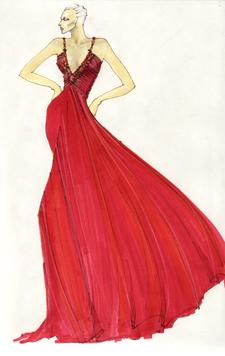What evening-wear designer Wayne Clark lacks in subtlety, he makes up for in self-deprecation. Sitting in O’Connor Gallery as incoming curator Geoffrey Person pours over sketches of big and bold ball gowns, the veteran designer dismissively refers to his illustration skills as “pretty good.”
“Once they’re taken out of my hands and get reproduced, I like the way they look,” he says. “But I don’t particularly like them when I sketch them.”
This is a year of retrospection for the 58-year-old designer. In April the Toronto chapter of the International Fashion Group honoured him at its Night of Stars gala at the Carlu alongside Dsquared’s Dan and Dean Canten and interior designer Brian Gluckstein. And during the upcoming Toronto Fashion Week, O’Connor Gallery will mount a retrospective of Clark’s fashion illustrations.
The exhibit will offer a comprehensive look at Clark’s creative process, chronicling almost four decades of red carpet-worthy glamour, from billowing blouses in 1973 and kitschy kimonos in 1983 to hot fuchsia Bollywood-inspired bodices in 2005.
“It’s so interesting to see behind the scenes of somebody’s suffering,” he says. “Everybody always says, ‘Oh, you most love what you do.’ On the very rare day, I do. More often than not it’s just hard work. But this [the sketches] is the fun part. This is the part where kids come in looking for a job as a designer and I go, ‘Are you serious? That’s the best part of the job. You are not going to come in here so I can pay you to sketch.'”
For some designers illustration is the first step in conceptualizing a collection. Visitors to Clark’s Logan Ave studio are confronted by a wall of sketches: elongated feminine silhouettes with dramatically sculpted posture and draped in wildly colourful eveningwear with flourishes straight out of the silent film era.
Clark began sketching dresses after he enrolled in Sheridan College’s design program (now defunct) in the early 1970s. Coming from an art school background, he tended to sketch the voluptuous women he saw in still-life drawing class, horrifying his fashion instructors.
Clark then apprenticed with Savile Row icon Hardy Amies before returning to Toronto to design for manufacturer Aline Marelle. He established his own company in 1989 becoming one of the first Canadian designers with international stature.
After school Clark quickly developed a more elegant eye that’s reflected in his illustration. “Wayne underrates himself as an illustrator and as an artist,” Person says, picking up a pencil sketch of a bright red mini bolero jacket. “I find the models’ faces really interesting. You compare them — these sort of carnival ones… you’ve got Marlene Dietrich. As much as the gowns have these trends or themes, the models’ faces also move through that as well.”
“These drawings have an immense significance in Canadian fashion history,” says Mary Symons, district director for Fashion Group International. “They represent an evolution, not just of Wayne’s aesthetic but of how fashion has evolved in this country and in the area of eveningwear and gala wear.
“Look at the intricate detail on this one,” she says reaching for an illustration from two springs ago of a short-haired, oval-faced black model wearing a brown monochrome number that nearly matches her skin. A balletic-looking short, high-waisted hoop skirt blooms from beneath a fitted, fur-rimmed jacket with a trippy, spiraling pattern. “It’s absolutely outrageous. The detailing of the jacket and how [he’s] captured the print is absolutely unreal to me.”
Despite their collectability as art pieces, the sketches serve a practical purpose in the production process. Clark takes sketches on business trips, photocopies them for pattern makers and rolls them up in samples. During buying season his sales teams demand sketches of each dress, and some retailers use them in marketing material.
Preliminary fashion sketches often emphasize the flawless ideal in a designer’s head over the practical reality of dress construction, but Clark says he’s been drawing for so long he’s incapable of falling too far into the retro glam fantasies that fuel his creativity.
“There was a time when I used to sketch for the sake of sketching,” he says. “Now I truly know how a garment goes together so as I’m doing that drawing I can’t draw something that I know I can’t physically make. Or at least think I can’t.”

 Why you can trust Xtra
Why you can trust Xtra


